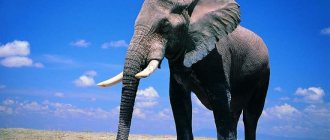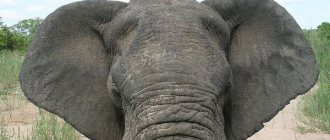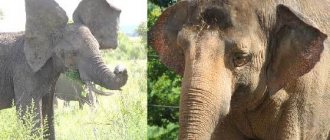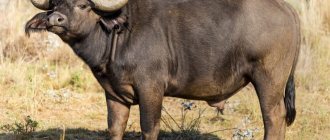elephant teeth
In the mouth of these land animals, in addition to the tusks protruding outward, there are four more molars (two each in the upper and lower jaw), consisting of many enamel scales connected to each other and allowing elephants to grind food. The Asian elephant has ribbon-shaped chewing teeth, while the African elephant has diamond-shaped chewing teeth.
Molars are replaced about six times throughout an elephant's life, with new teeth growing behind the old ones.
As for the shape of the tusks, the Indian (Asian) elephant has thin ones (females have no tusks at all). The tusks of the African elephant are thick and huge, and their length sometimes reaches two or more meters.
Anatomical and physiological characteristics of elephants
The elephant family includes three species of living elephants, belonging to two genera: African and Asian (Indian). The remaining species became extinct during the Ice Age, which ended about 10,000 years ago. The structure of African and Asian (Indian) elephants is somewhat different. They differ in size, body shape, shape of ears, teeth, structure of the trunk and legs, as well as type of nutrition. The anatomy of elephants differs in many ways from that of other mammals. Within the scope of my report it is impossible to fully describe the structure of these animals. Let me draw your attention to some anatomical and physiological features that must be taken into account both when keeping elephants in captivity and during veterinary care. Elephants are huge animals with a massive and short body, straight, column-shaped thick legs, a short neck and a large but fairly proportional head.
How else is the Indian elephant different from the African one?
The tusks of the largest adult Indian elephant grow to a maximum of one and a half meters in length and weigh 20 - 25 kg. The height of this animal can reach 3 m and weight – 5 tons.
The tusk of an elephant that grew up in northern India is thick and strongly curved, while the tusks of its relatives that settled in southern Africa are thin and sharp, and the further south the territory, the thinner and sharper these formations are.
Indian elephants, unlike African ones, live exclusively in the forest, with preference given to undergrowth of bamboo thickets.
African elephants live in both forests and savannas, and are the largest land mammals, as evidenced by an entry in the Guinness Book of Records.
An ordinary African elephant weighs up to 5 tons, and a female elephant weighs more than 2, but less than 3 tons. The maximum length of an African elephant tusk is 3 m.
The largest representative of this species of elephant was shot in 1974 in Angola. This male weighed more than 12 tons.
Elephant - description and characteristics
The majestic animal has practically no enemies and does not attack anyone, being a herbivore. Today they can be found in the wild, in national parks and reserves, in circuses and zoos, and there are also domesticated individuals. A lot is known about them: how many years elephants live, what elephants eat, how long an elephant’s pregnancy lasts. And yet secrets remain.
How much does an elephant weigh?
This animal cannot be confused with any other, since hardly any land mammal can boast of such dimensions. The height of this giant can reach up to 4.5 meters, and its weight can reach up to 7 tons. The largest is the African savannah giant. Indian counterparts are somewhat lighter: weight up to 5.5 tons for males and 4.5 tons for females. Forest elephants are considered the lightest - up to 3 tons. In nature, there are also dwarf varieties that do not reach 1 ton.
Elephant skeleton
The elephant's skeleton is strong and allows it to withstand such an impressive weight. The body is massive and muscular.
The animal's head is large, with a protruding frontal area. Its decoration is its movable ears, which serve as a heat regulator and a means of communication between fellow tribesmen. When attacking a herd, the animals begin to actively move their ears, scaring off enemies.
The legs are also unique. Contrary to the popular belief that animals are noisy and clumsy, these giants walk almost silently. The feet have thick fat pads that soften the step. A distinctive feature is the ability to bend its knees; the animal has two kneecaps.
The animals have a small tail ending in a non-furry brush. Usually the cub holds on to it in order to keep up with the mother.
Elephant trunk
A distinctive feature is the elephant's trunk, the mass of which in an elephant can reach up to 200 kg. This organ is a fused nose and upper lip. Consisting of more than 100 thousand strong muscles and tendons, the elephant's trunk has incredible flexibility and strength. They use it to pick off vegetation and put it in their mouth. Also, the elephant's trunk is a weapon with which it defends itself and fights its opponent.
The giants also draw in water through their trunks, which they then put into their mouths or pour over. Elephants up to one year old have little control over their proboscis. For example, they cannot drink with it, but kneel down and drink with their mouth. But they hold tightly to their mother’s tail with their trunk from the first hours of their life.
Elephant vision and hearing
Relative to the size of the animal, the eyes are small, and these giants do not differ in acute vision. But they have excellent hearing and are able to recognize sounds even at very low frequencies.
It is believed that animals hear thunder at a distance of up to 100 km and can accurately locate water located at a great distance by noise.
Leather
The body of a large mammal is covered with thick gray or brown skin, mottled with many wrinkles and folds. Sparse hard bristles on it are observed only in cubs. In adults it is practically absent.
The color of the animal directly depends on its habitat, since elephants often sprinkle themselves with earth and clay to protect themselves from insects. Therefore, some representatives appear brown and even pink.
Among giants, albinos are very rare, but still found. Such animals are considered iconic in Siam. White elephants were taken specifically for royal families.
Jaws
The decoration of the giant is its tusks: the older the animal, the longer they are. But not everyone is the same size. The female Asian elephant, for example, is completely devoid of such decorations by nature, just like rare males. The tusks fit into the jaws and are considered incisors.
How many years an elephant lives can be determined by its teeth, which wear down over the years, but at the same time new ones appear, growing behind the old ones. It is known how many teeth an elephant has in its mouth. As a rule, 4 radicals.
It was the tusks of these giants that were very highly valued, which led to the brutal extermination of proboscideans. Now hunting is strictly prohibited: the animal is listed in the Red Book. And the places where the elephant lives are declared nature reserves.
The Indian elephant and the African elephant have external differences, we will talk about them in the sequel.
Amazing details
Elephants do not feel panic at all when meeting a mouse - this is fiction. To blow away such a tiny animal, and with it the nearby stones and other heavy objects, the elephant only needs to exhale.
These giants are truly afraid of ordinary honey bees. Hearing the buzz of an approaching swarm of bees, the elephants immediately take to their heels. But these animals can hardly be called cowardly creatures. They are very careful and smart. By the way, the elephant is included in the list of the most intelligent animals on Earth.
Few people know that the elephant has exceptional hearing, as well as excellent memory and sense of smell. An elephant is able to remember places that are significant to it, as well as people who treated it badly (or well). But the most amazing quality of the elephant is its good ear for music, which allows it to remember and subsequently recognize a melody of three notes. True, he likes low notes much more than high and sonorous ones.
Unlike the rest of the animal kingdom, the elephant seems to have an understanding of death. Elephants are able to identify the corpses (and even bones) of their fellow tribesmen. Researchers were amazed at how the indifference with which elephants treat the remains of other living beings was replaced by a manifestation of care and compassion towards the corpses of their relatives.
Having seen the skeleton of an elephant, these animals cannot pass by: they begin to intensely feel the remains with their trunks, paying special attention to the head of the deceased. Having thoroughly probed the skull with their trunks, as if trying to identify their untimely departed friend, the elephants do not throw his lifeless body to be torn apart by scavenger animals, but cover it with dry leaves.
When one of the members of the herd is mortally wounded, healthy elephants, as if seeing off a relative to a better world, stand vigil around him and do not leave until the very end...
Social life
Female elephants, as a rule, live in herds of about 10 females under the leadership of the most experienced female elephant, while male elephants are often solitary and migrate from herd to herd. The females in each herd help each other find food and care for the young. They do not sleep on the ground because their very straight legs give them excellent support. Elephants communicate with members of their herd at a distance of many kilometers, using sounds too low for human perception, as well as by stomping. Elephant herds are thought to exhibit similar levels of cooperation to chimpanzees. A herd of elephants is considered one of the most close-knit animal communities, and a female will only be kept if she dies or is captured by humans. Males leave the herd when they become juveniles at age 12 and live in temporary male herds that disband as the males mature.
Why does an elephant need tusks?
With the help of this “tool” the elephant uproots trees and sometimes defends itself from enemies, the main of which is man. A maddened elephant with tusks (photo below), the length of which is sometimes equal to its own height, poses a serious danger to both its fellows and humans, but rabid elephants are a rare phenomenon. Elephant tusks are more of a punishment from nature than a gift. The fate of African elephants, whose tusks have always been highly valued, is especially sad.
With the arrival of a white man with a gun on the “dark” continent, Africa ceased to be an “elephant’s paradise.” Ruthlessly exterminating good-natured giants for the sake of precious tusks, European poachers left their carcasses to be devoured by hyenas and vultures.
What do elephants eat?
Being herbivores, proboscis spends more than 15 hours a day in search of food. To maintain their enormous body mass, they have to eat 40 to 400 kg of vegetation per day.
What elephants eat directly depends on their habitat: it can be grass, leaves, young shoots. The elephant's trunk picks them off and sends them into the mouth, where the food is thoroughly ground.
In captivity, the elephant eats hay (up to 20 kg per day), vegetables, especially carrots and cabbage, a variety of fruits, and grains.
How many years an elephant lives depends on what elephants eat. Zoo visitors often feed animals contraindicated food. Huge mammals are strictly prohibited from eating sweets.
Sometimes wild animals wander into the fields of local residents and happily eat the harvest of corn, cane, and grain.
Where is the elephant cemetery?
Interesting fact: no one has ever found the tusks of dead African elephants.
This circumstance formed the basis of numerous legends that the inventive local population never tires of inventing. The most notorious smugglers were already ready to believe in the existence of mysterious elephant cemeteries... but then wildlife researchers got down to business. According to information provided by 20th century naturalists, elephant tusks serve as a source of minerals for porcupines, which are completely deprived of the minerals contained in the soil with the arrival of the rainy season.
The question of the disappearance of tusks remained open for a long time due to the fact that porcupines are nocturnal animals.
Death
There is no evidence of the existence of elephant cemeteries, but death for them is nevertheless a very important process. Their normal life expectancy is 60-80 years. Elephants, humans and Neanderthals are the only species that observe death rituals. If one of the elephants gets sick, other members of the herd will look after him, bring him food and support him. If the elephant dies, then for some time they will try to “resurrect” it with food and water. Once it becomes clear that an elephant has died, the herd becomes very quiet, often digging a shallow grave and covering the dead elephant with branches. After this, they will remain near the grave for several days. If the elephant was especially close to someone, then his friend may show signs of depression. Even a herd that passes by a deceased elephant from another herd pays respect to him. There is also evidence that elephants buried dead people.
How to distinguish an elephant tusk from a fake made of another material
Experts working with antiques note that very often the role of elephant tusks is given to high-quality plastic or ceramic fakes that look very similar to carved ivory.
Some counterfeiters pass off synthetic materials filled with bone chips as elephant tusks, which are also difficult to distinguish from natural material. To make fakes, in most cases, casting and hand-painting methods are used. If you look at the work of counterfeiters with the naked eye, you can detect seam lines and marks from sprues. But the main difference is considered to be the unnatural smoothness and lightness of non-natural products.
Other, cheaper bones are often passed off as elephant tusks, but the reason is not always the high cost of the natural material. It’s just that often sellers, being essentially resellers, do not themselves know what they are selling.
There are also frequent cases when items made from the bones of their ancient ancestor, the mammoth, were passed off as items made from elephant ivory. By the way, mammoth tusks are prohibited not only from transportation, but also from processing.
The Thai authorities decided to undertake an interesting experiment in March 2015 by legalizing the possession of ivory. The population was asked to register the tusks of elephants and mammoths illegally stored in their homes, in order to turn from smugglers into law-abiding citizens.
As it turned out, almost all residents of the country keep ivory souvenirs. Those of them who decided to register their treasures, as promised, were released by the state from liability for illegal possession of contraband goods.
As it turned out, in many families, products made from ivory and mammoth ivory played the role of heirlooms and were kept for posterity. Now owners of family valuables can rest easy.
Thai citizens who do not respond to the authorities' call face a fine of $200,000 or 3 years in prison.
Elephants are not pets
If people bred elephants like, say, cows or horses, they would probably create breeds: the white Ceylon elephant or the Burmese draft. But sometimes elephants are tamed. Mostly Indian, since African ones are larger and their character is not so flexible. Once upon a time, these huge and intelligent animals replaced peaceful tractors and battle tanks for the inhabitants of Southeast Asia (Alexander the Great first encountered them during his famous Indian campaign), during the First World War in Europe, which was left without horses and cows, on elephants plowed, and today they are used to give rides to tourists. This small photo project is dedicated to the relationship between people and elephants.
How do mammoth tusks differ from elephant tusks?
Mammoth tusks have no voids. Having a solid, uniform texture, they delight the eye with a variety of colors (from pale cream to deep black) and pronounced chiaroscuro.
The cross section of mammoth tusks has a heterogeneous color, reminiscent of alternating dark and light rings dotted with radial or circular cracks. The white color of the tusk and tiny texture are characteristic signs of low-quality material.
The main feature by which one can determine that the “elephant tusk” actually belonged to a mammoth is a “mesh” pattern that opens when cross-sawed. The mesh is formed by interlacing of thin grooves and nerve fibers.
How much does an elephant weigh on average?
Savanna elephant: 6,000 kg
Interesting materials:
Is it possible to register someone other than the husband as the father of the child? Is it possible to record a video conversation in Viber? Is it possible to make an appointment with a psychologist without parents? Is it possible to record conversations on WhatsApp? Is it possible to power an outlet from a wall outlet? Is it possible to refill an HP 122 cartridge? Is it possible to set off fireworks in yards? Is it possible to start viewing a presentation from the current slide? Is it possible to make eyelash extension bundles in advance? Is it possible to book Aeroflot seats in advance?
Feet
Each elephant foot contains five toes, but not every toe has a nail. The easiest way to tell the two species of African elephants apart is by counting their nails. The African forest elephant and the Asian elephant have five nails on their forelimbs and four nails on their hind limbs. However, the African savannah elephant has only three nails on its hind legs. An x-ray of an elephant's leg will show that its bones are actually "standing on tiptoes." Their feet are flat and there is cartilage under each heel that acts as a shock absorber, helping them walk smoothly. Their legs are much straighter than those of other animals, and they support the weight of the animal so well that elephants sleep standing up. Elephants spend most of their lives walking vast distances, so their feet are properly adapted to such a life. Zoo officials often note that the elephants they keep often develop foot problems due to lack of constant walking.
Intelligence
Elephants are among the most intelligent animals on Earth. Their brain weighs 5 kg, which is much more than the brain of any other animal. Their brain consists of complex convolutions (more of which only whales have), which is considered one of the factors determining their intelligence. They can generally show grief, humor, compassion, cooperation, self-awareness, playfulness, and they also have excellent learning abilities. Elephants have a highly developed hippocampus, the area of the brain responsible for emotions and spatial awareness. Research shows they outperform humans at tracking multiple objects in 3D space. There is much evidence demonstrating elephants' altruism towards other species, such as rescuing dogs at significant cost to themselves. As mentioned above, they respect their deceased relatives and observe rituals.











